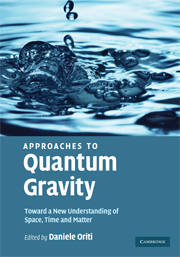Book contents
- Frontmatter
- Contents
- List of contributors
- Preface
- Part I Fundamental ideas and general formalisms
- Part II String/M-theory
- 10 Gauge/gravity duality
- 11 String theory, holography and Quantum Gravity
- 12 String field theory
- Questions and answers
- Part III Loop quantum gravity and spin foam models
- Part IV Discrete Quantum Gravity
- Part V Effective models and Quantum Gravity phenomenology
- Index
12 - String field theory
from Part II - String/M-theory
Published online by Cambridge University Press: 26 October 2009
- Frontmatter
- Contents
- List of contributors
- Preface
- Part I Fundamental ideas and general formalisms
- Part II String/M-theory
- 10 Gauge/gravity duality
- 11 String theory, holography and Quantum Gravity
- 12 String field theory
- Questions and answers
- Part III Loop quantum gravity and spin foam models
- Part IV Discrete Quantum Gravity
- Part V Effective models and Quantum Gravity phenomenology
- Index
Summary
Introduction
In the early days of the subject, string theory was understood only as a perturbative theory. The theory arose from the study of S-matrices and was conceived of as a new class of theory describing perturbative interactions of massless particles including the gravitational quanta, as well as an infinite family of massive particles associated with excited string states. In string theory, instead of the one-dimensional world line of a pointlike particle tracing out a path through space-time, a two-dimensional surface describes the trajectory of an oscillating loop of string, which appears pointlike only to an observer much larger than the string.
As the theory developed further, the need for a nonperturbative description of the theory became clear. The M(atrix) model of M-theory, and the AdS/CFT correspondence, each of which is reviewed in another chapter of this volume, are nonperturbative descriptions of string theory in space-time backgrounds with fixed asymptotic forms. These approaches to string theory give true nonperturbative formulations of the theory, which fulfill in some sense one of the primary theoretical goals of string theory: the formulation of a nonperturbative theory of Quantum Gravity.
There are a number of questions, however, which cannot – even in principle – be answered using perturbative methods or the nonperturbative M(atrix) and AdS/CFT descriptions. Recent experimental evidence points strongly to the conclusion that the space-time in which we live has a small but nonzero positive cosmological constant.
- Type
- Chapter
- Information
- Approaches to Quantum GravityToward a New Understanding of Space, Time and Matter, pp. 210 - 228Publisher: Cambridge University PressPrint publication year: 2009
- 6
- Cited by

